Cricket
Mukesh Kumar’s journey from Bihar to Delhi Capitals
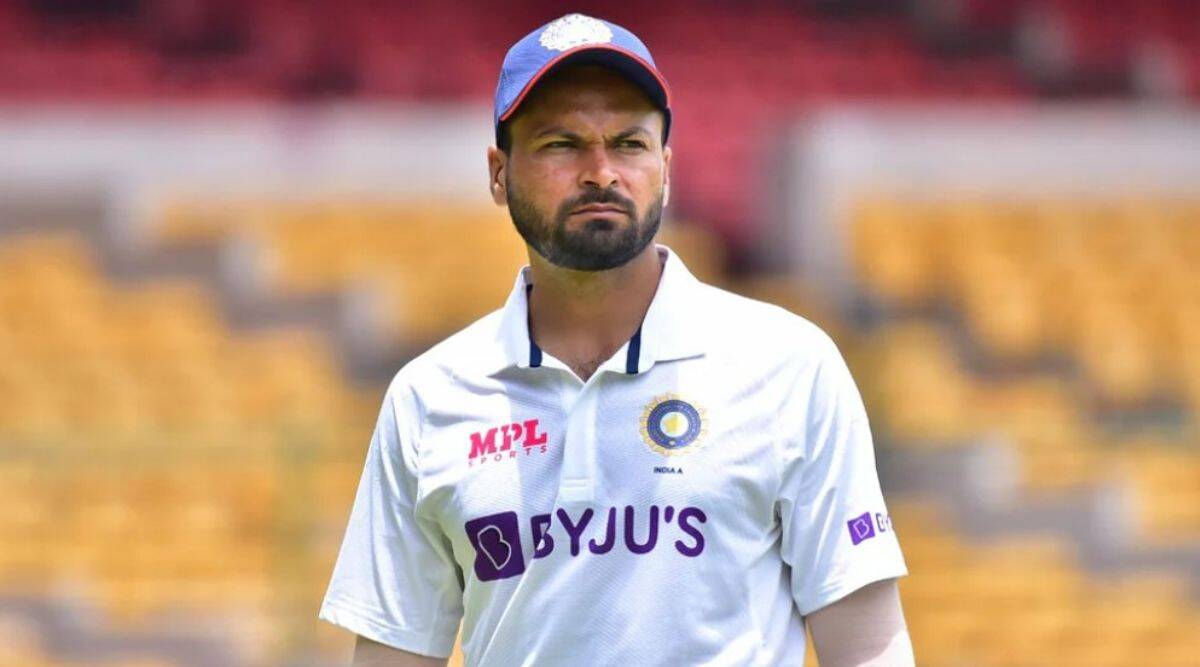
Delhi Capitals signed fast bowler Mukesh Kumar, 29, for Rs 5.5 crore ($660,000) a day after the IPL auction in Kochi. He’s been receiving congratulations and media calls nonstop. Mukesh, who got the second-highest bid for an uncapped athlete, can’t believe it.
His heart and thoughts are at Gopalganj, his home town in rural Bihar, while he’s in recovery in Bengaluru.
His “happy place” is the farm. Any place with fresh air. There’s peace.
“After 10 days of therapy, I’m bowling today,” he says. “It’s thrilling. “Hard-to-explain”
Mukesh’s first IPL auction was Sunday. Friend’s frantic calls saved him from missing the big event.
“I watched the auction and then the India-Bangladesh Test,” he says. “When I called my mom, I continued getting missed-call alerts. Something was up when my friend kept contacting me. Did you see?
“So I switched back to the auction, but I still couldn’t believe it was my name, because so many times before I was told I had a strong chance but my name never came up. “I couldn’t believe it until I saw my photo next to my name.”
Several times, he pauses. “Bittersweet,” he admits. “God gives and takes. I never thought I’d see this much money in my lifetime, yet my father and uncle, who I should be sharing this with, are dead.
Stroke killed Mukesh’s father two years ago. His bade papa, father’s older brother, who supported him when he went to Kolkata in 2012, died in November.
“I’ll never forget my father’s excitement when I presented him my Ranji allowance. Wish I’d given him more. But now, I can’t. Hence my tears. Money isn’t everything.
Mukesh studied for three years to pass the tests to join the Central Reserve Police Force (CRPF) and the Bihar police. In 2012, he finally passed the written tests, but he was turned down because he wasn’t fit. About this time, he made a serious decision to switch to cricket.
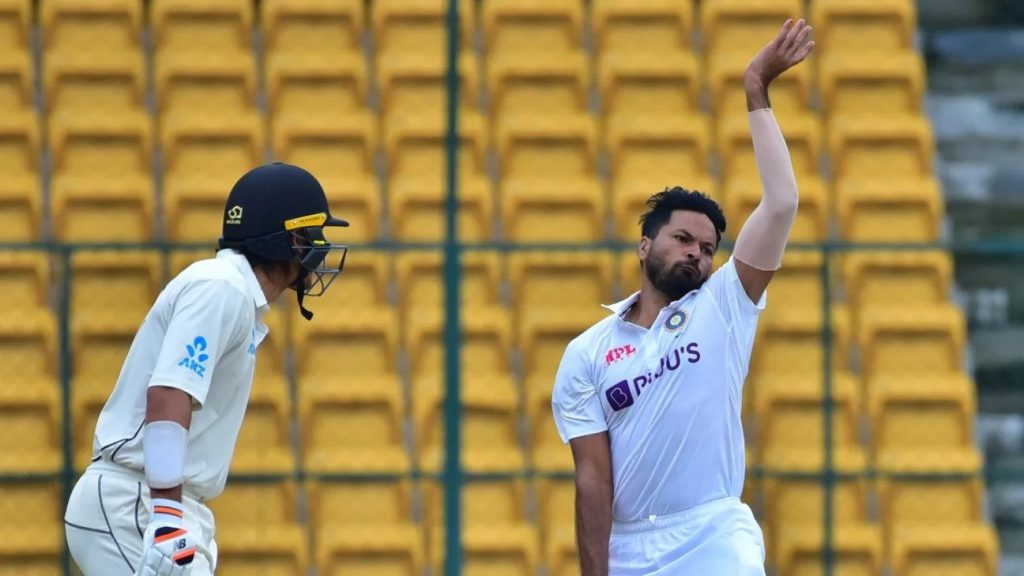
In action against New Zealand A earlier this year in Bengaluru. In the first innings of the first match, Mukesh took 5 wickets for 86 runs.
Bihar wasn’t allowed to play in India’s most important domestic tournaments, so Mukesh didn’t have a chance to play in his home state. He worked as a paid tennis-ball cricket player for fun. He played in tournaments with prize money that was enough to cover his basic needs. But when he had a bike accident during one of these tournaments in Bihar, his father, who had been running a taxi service in Kolkata since 2003, decided it was time to step in and asked him to move to the city.
“He told me in no uncertain terms that from now on, everything I do, whether it’s cricket or something else, will only happen in Kolkata and nowhere else. He was keeping an eye on me “Mukesh says. “Even though I wasn’t very serious about it, I signed up for a graduation program that I could do from home. I just wanted to show my dad that I was doing my homework.
“My dad thought, “Okay, this guy will play cricket, find out how hard it is to get anywhere in Kolkata, and give up.” And when he finishes school, I can try to find him a job somewhere.’ I guess he was wrong. Because I became more and more interested in serious red-ball cricket.”
Mukesh first went to the prestigious Kalighat Club, but he was sent away. He was told by a club official that he would have to work as a bartender for at least two years before he would even be considered because “only the big players play here.” Mukesh then went to the Bani Niketan Sports Club, where he met Birendra Singh. Birendra Singh was his trainer and later became his mentor.
“In my first game for Bani Niketan, a second-division league game, I took six wickets,” he says. “The next year, I moved up to a team in the first division. But I couldn’t play as often because my dad’s health was getting worse. He really wanted me to get a job and become more stable. I said, “Give me another year,” and kept playing.
Around this time, in the middle of 2014, Sourav Ganguly, who was then the secretary of the Cricket Association of Bengal, announced his Vision 2020 program to pick talented cricketers to help Bengal become a powerhouse in domestic cricket. Waqar Younis, Muthiah Muralidaran, and VVS Laxman were brought in for the program to help local coaches narrow down a group of players who could then be trained over time. Birendra suggested that Mukesh be let into the trials, where he had to compete with more than 300 other people.
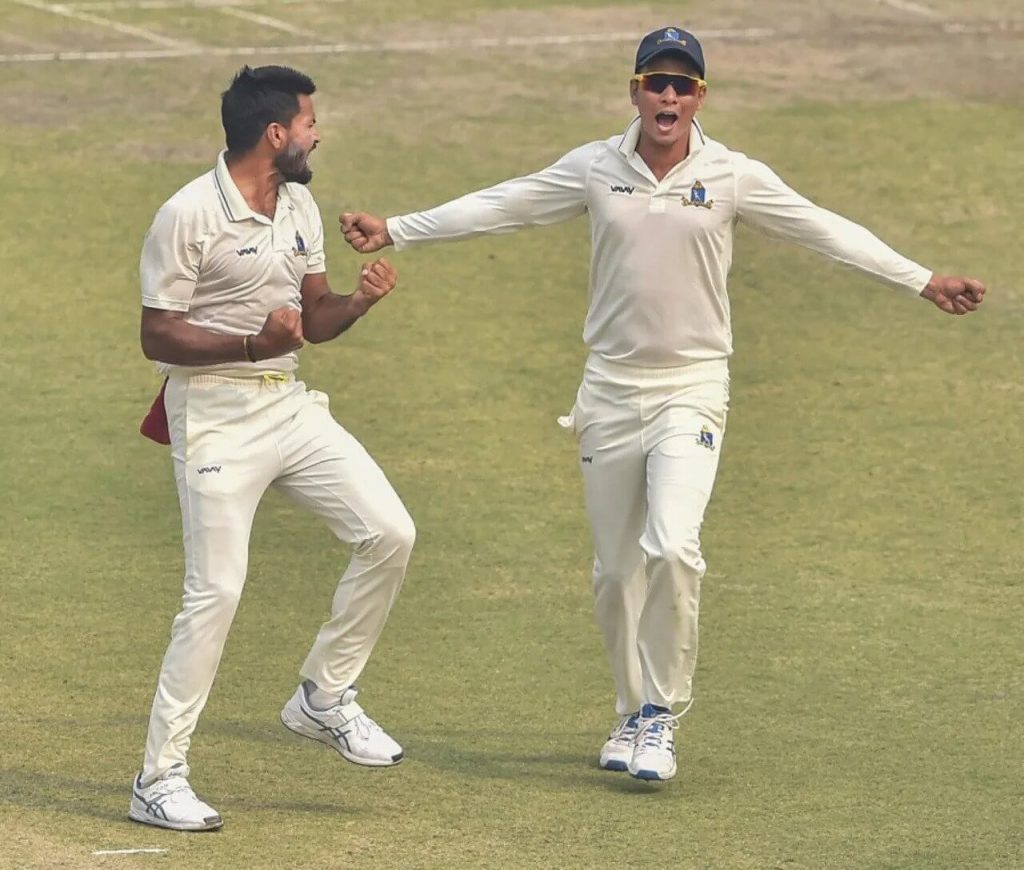
Mukesh during his six-for against Karnataka in the 2019-20 Ranji semi-final
“At the end of the trials, there were only four or five bowlers left, but I got called when I went to the bathroom,” Mukesh says. “Since no one replied, my name was taken off the list. I had to literally beg Rono da [Ranadeb Bose, an ex-Bengal seamer who helped run the trial] to give me a chance.
“I knew I only needed four or five balls to change things. I found out that I had been chosen later that evening. So, it was a good thing that I stood all day in the sun.” It turned out that Bose had told Waqar about Mukesh’s case.
“I thought there was something about him when I saw him bowl,” says Bose. “Waqar wasn’t sure, but I asked him to do it. ‘Bhai, rakh lo’ [Let’s keep him]. “Are you sure?” he asked. And I said, ‘Mere ko achha lag raha hai.’ [I like him] He said, ‘Theek.’
“Even I might have missed him at the end of a long day. But I went behind the nets to get a cup of tea by chance. So I could watch him from behind the batter, and I thought he was pretty good.”
Getting through the trials was only the first step. The next step was to meet the fitness requirements. During this time, it was discovered that Mukesh had fluid buildup in his knees (called bone edema) and that he was anemic. It meant he had to spend more time in hospitals and rehab centers and had to miss three games for every one he played.
“CAB helped me a lot during this time. They got me MRIs, paid my medical bills, and even let me stay in their housing,” he says. “I don’t think I would have made it without their help. Between 2014 and 2015, I did nothing but rehab for eight months. It was really hard. At times, I thought it might be best to go back to the village. I wanted to try, though. If it didn’t work, it didn’t work. I had to at least give it a shot.”
In 2015, Mukesh made his Ranji Trophy debut against Haryana in Lahli. This was after he got back in shape and did well in club tournaments.
Before the game, there was growing unhappiness on the Bengal team because an injury-prone “outsider” was chosen over several state regulars. Bose, who was the bowling coach, stood up for Mukesh with the help of Laxman and the head coach, Sairaj Bahutule.
Mukesh got rid of the first batsman, Rahul Dewan, and then he got rid of Virender Sehwag. He ended up taking five wickets in the game. Bose says, “He saved my job.”
That season, Mukesh played in four games. In 2016–17, he only played two games before getting hurt. When he was healthy again, he had lost his form, so he went back to club cricket. Even though he was healthy, he only played one game the next season. Bengal already had Mohammed Shami and Ashok Dinda, so it was hard for him to make the team as a fast bowler. In the 2018-19 season, he played five games and took 22 wickets. The following season, he was a real part of a good pace attack. He got ten games because he had done well in club cricket. It helped that Dinda had left the team after getting into a fight with the team’s management and leaving a spot open. The national selectors were impressed by Mukesh’s control of the ball and his ability to move it around on different surfaces. He took 32 wickets, which was a lot.
In the semi-final, Mukesh got 6 for 61 in the second innings against a Karnataka team that included KL Rahul, Manish Pandey, Devdutt Padikkal, and Karun Nair, among others. This put Bengal in the position to play for the title.
“That season was a turning point, but Covid struck within two weeks, right when the selectors had told me I would play in the Duleep Trophy and Irani Cup. And we were back to where we started.”
During his forced downtime, he worked on his endurance and ran cross-country to get in better shape. “After seeing Ben Stokes and Steven Smith do a charity run, I even ran 20 km in two hours,” he says. “I might not have been able to do that even five years ago. Today, I’m in much better shape.”
Mukesh made it into the India A team for the home series against New Zealand A earlier this year. In the second unofficial Test earlier this month, he took 6 wickets for 40 runs while playing for India A. In between his two stints, he was picked for the home series against South Africa as an ODI player. Even though he didn’t play, the fact that he made a mark like that even though he hadn’t played in the IPL yet makes his journey even more special.
The biggest change Mukesh has made in the last three years is that he is no longer only known for his red-ball exploits. At the IPL, he wants to build on this. But he’s looking forward to going home to see his mother before he gets there.
He says, “I want to show her the whole country.” “We went to Shirdi not long ago. I gave her a tour of a temple. That makes her happy, and if I take her, I’ll be happy too.
“”What will you do with so much money?” people have asked. I don’t have any big dreams, as you can see. I love working in the fields to grow crops and do farming.
“I’m the kind of person who likes to eat with family while sitting on the floor. When I’m not on the field, that makes me very happy. It’s not a hard life.
“If I want to go back to farming in my village after cricket, I might be able to make my dream come true by investing the money. But all of that will have to wait. Now I just want to get in shape and play as much cricket as I can.”
Cricket
1000 Runs in ODIs: Kohli’s Cricket Legacy
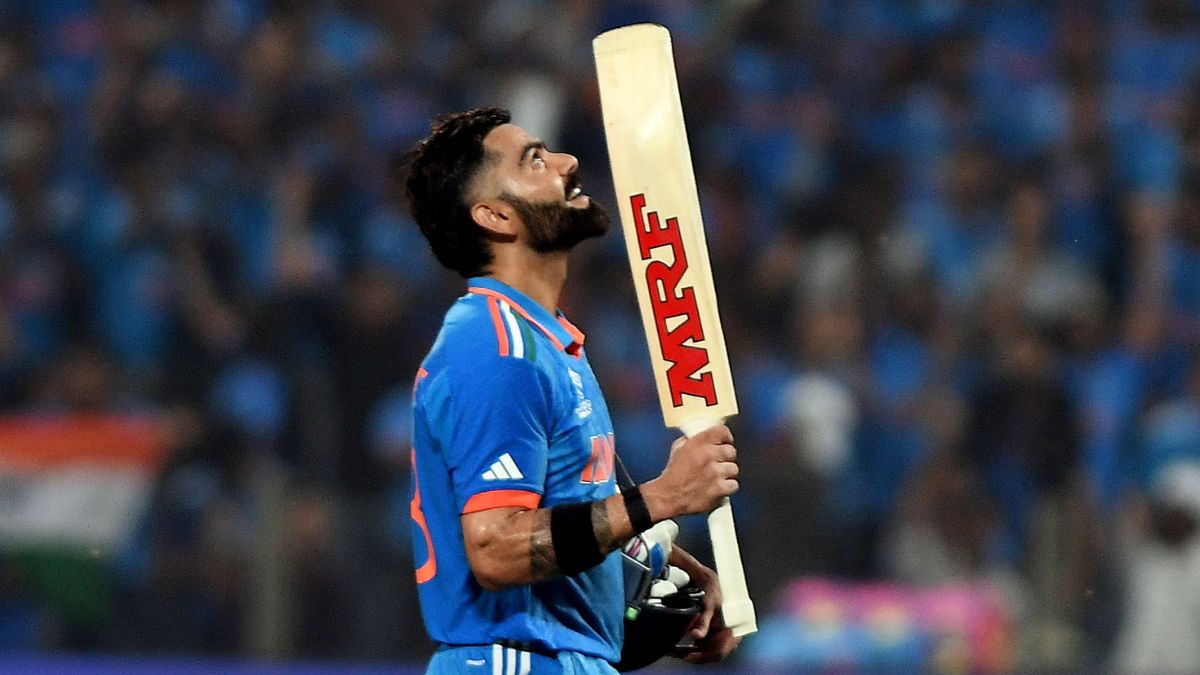
On Thursday, November 2, Virat Kohli achieved an accomplishment. He became the batsman to surpass 1000 runs in ODIs in 2023, following in the footsteps of Shubman Gill and Rohit Sharma. Not that,. He also joined Rohit Sharma, Shubman Gill, and Pathum Nissanka as the fourth players to achieve this impressive record in the 50-over format within the same year.
Stepping into History with 1000 Runs in ODIs
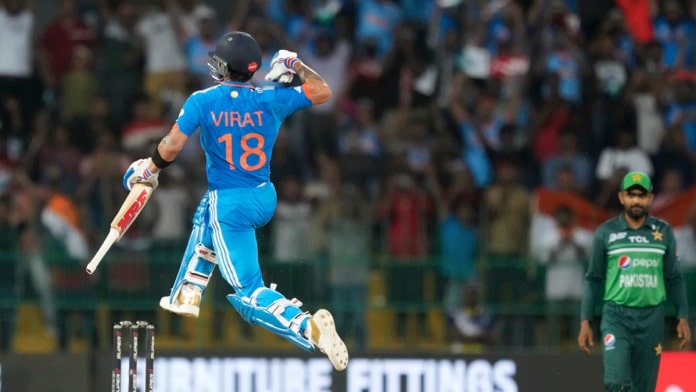
Entering the realm of history, Kohli’s unwavering determination and exceptional skills were put on display during his match in 2023. Notably, the cricket maestro, now 34 years old, made an indelible impact by surpassing Sachin Tendulkar‘s record, securing the most number of years with 1000 runs in ODIs. Kohli’s consistent ability to perform at such an exceptional level has been a defining characteristic of his illustrious career, as he had previously achieved this monumental milestone in 2011, 2012, 2013, 2014, 2017, 2018, and 2019, before accomplishing it once again in the present year of 2023.
Sachin Tendulkar with god of cricket Virat Kohli pic.twitter.com/zmztejNBBB
— Kevin (@imkevin149) November 2, 2023
An Unforgettable Journey
In an intense World Cup 2023 clash against Sri Lanka at the renowned Wankhede Stadium in Mumbai, Virat Kohli’s pursuit of this historic milestone was realized with an impressive 34 runs. Despite facing challenges, including a rare duck against England at the Ekana Stadium in Lucknow, his overall performance throughout the year has been nothing short of spectacular.
Kohli’s memorable journey was highlighted by an unbeaten century during India’s triumphant seven-wicket victory against Bangladesh at the Maharashtra Cricket Association (MCA) Stadium in Pune. Adding to his illustrious record, he solidified his stature with a brilliant 95 runs, making a significant contribution to India’s thrilling four-wicket win over New Zealand led by Tom Latham at the Himachal Pradesh Cricket Association (HPCA) Stadium in Pune.
Cricket
Shaheen Shah Afridi: Fastest to 100 ODI Wickets

Shaheen Shah Afridi, on Tuesday, October 31, achieved a remarkable feat, becoming the third fastest bowler to secure 100 wickets in ODIs. His outstanding performance during Pakistan’s World Cup 2023 match against Bangladesh at the renowned Eden Gardens in Kolkata led to this historic accomplishment.
A Landmark Moment
In the thrilling encounter, Shaheen clinched his 100th wicket in only his 51st match, dismissing Tigers’ opening batter Tanzid Hasan Tamim. The left-arm fast bowler displayed exceptional skill as he struck Tamim on the pads, prompting the on-field umpire to raise his finger. Despite Tamim’s referral to the third umpire using the Decision Review System (DRS), the replays confirmed the ball crashing into the stumps, upholding the on-field decision. Bangladesh lost their first wicket with the scoreboard reading 0 in just 0.5 overs.
Shaheen Afridi soars high yet again with another feat to his name 🦅#CWC23 | #PAKvBAN pic.twitter.com/IlQQ6P5xYK
— ICC Cricket World Cup (@cricketworldcup) October 31, 2023
Surpassing Preceding Records
Shaheen Shah Afridi not only secured this feat in record time but also outshone the accomplishments of esteemed bowlers preceding him. He surpassed the record of the fastest pacer, previously held by Mitchell Starc, who attained the milestone in August 2016 during an ODI against Sri Lanka at the R. Premadasa Stadium in Colombo.

Legacy of Excellence
Moreover, Shaheen shattered the long-standing record held by Saqlain Mushtaq, becoming the fastest Pakistani bowler to claim 100 wickets in ODIs. Saqlain had set this record on May 12, 1997, during an ODI against Sri Lanka in Gwalior. It is notable that among the Pakistani fast bowlers, the accomplished Shaheen Shah Afridi follows in the footsteps of the legendary Waqar Younis, who achieved the 100-wicket mark back in February 1993 against Zimbabwe in Sharjah.

Beyond ODIs
Demonstrating his prowess beyond ODIs, Shaheen has made significant contributions in Tests and T20Is as well. Since his debut in 2018, he has garnered 105 wickets in Tests and 64 wickets in T20Is. His exceptional journey began with a strong performance in the U19 World Cup in New Zealand. Notably, he played a pivotal role in Lahore Qalandars’ consecutive victories in the Pakistan Super League (PSL).
A Testament to Talent and Dedication
Shaheen Shah Afridi’s rapid rise to 100 ODI wickets within 51 matches underlines his exceptional talent and unwavering dedication to the sport. As he continues to leave an indelible mark on the cricketing world, his journey serves as an inspiration for aspiring cricketers worldwide. With his remarkable achievements, Afridi has solidified his place in the annals of cricket history, etching his name as one of Pakistan’s most formidable and promising fast bowlers.
Cricket
ICC World Cup: Shoaib Akhtar says, ‘Mai India ki tareef kyu na karu’

Former Pakistan fast bowler Shoaib Akhtar has recently expressed admiration for India’s dominant performance in the ongoing 2023 ICC World Cup. With India securing victories in all six matches, Akhtar highlighted the team’s exceptional display across various aspects of the game. Although the recent batting performance against England in Lucknow was relatively modest, India’s fierce bowling attack, led by Mohammed Shami and Jasprit Bumrah, proved instrumental in securing a remarkable win. This triumph not only solidified India’s leading position on the points table but also exacerbated England’s struggles in the tournament, leaving them virtually eliminated.
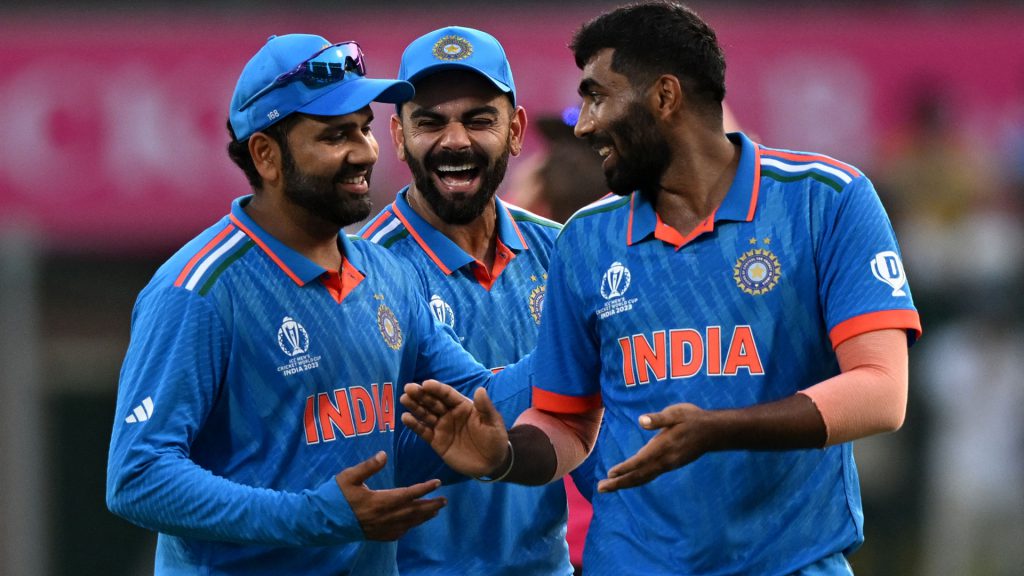
India’s Remarkable Bowling Transformation
In his analysis, Akhtar emphasized the transformative impact of Shami’s inclusion in India’s playing eleven following Hardik Pandya’s injury. Acknowledging Shami’s outstanding performances against New Zealand and England, Akhtar credited India’s ability to win matches through their bowling prowess, showcasing a shift from their traditional reliance on batting strength. He commended the collective effort of the Indian bowling unit, particularly recognizing the strategic brilliance of fast bowler Bumrah.
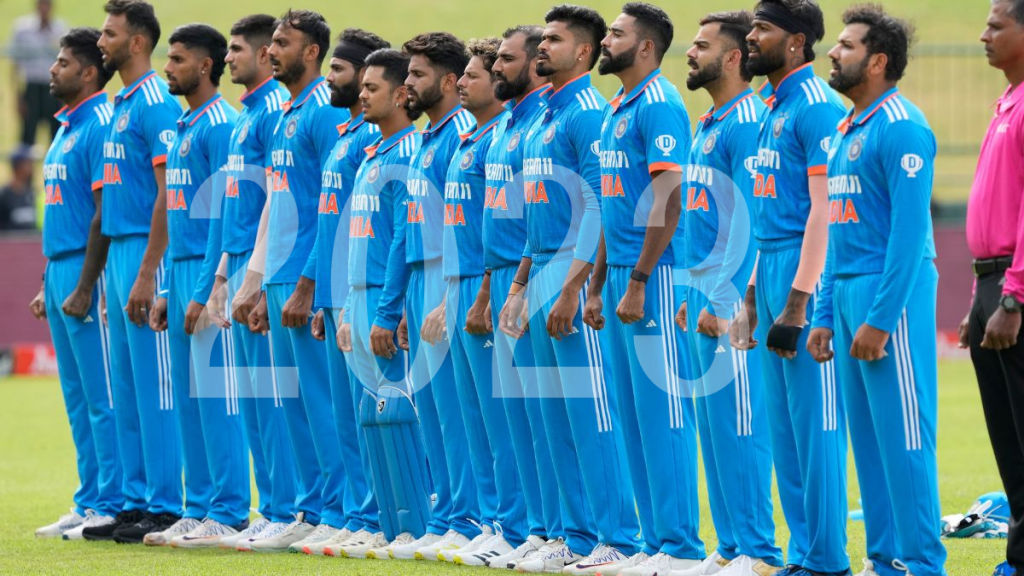
India’s Path to World Cup Glory
Looking ahead, Akhtar voiced his confidence in India’s potential to secure their third ODI World Cup trophy, highlighting the team’s upcoming matches against Sri Lanka, South Africa, and the Netherlands. Expressing optimism, he emphasized the significance of maintaining their unbeaten streak en route to the final, setting the stage for a potential historic ICC World Cup victory. However, Akhtar cautioned against compromising the successful bowling unit once Pandya returns to full fitness, warning against the potential detriment of a partially fit Pandya’s inclusion at the expense of a bowler.
Akhtar’s Praise for India and its Response to Criticism
Addressing skepticism surrounding his praise for the Indian team, Akhtar reiterated the exceptional nature of India’s performance, particularly in their ability to defend a modest total with a significant margin of victory. Undeterred by criticism, Akhtar reaffirmed his admiration for India’s exceptional cricketing prowess, urging acknowledgment and appreciation of their commendable achievements.
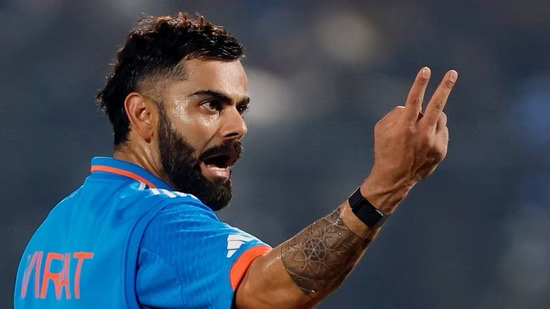
Shoaib Akhtar’s Perspective on Virat Kohli
Shifting focus, Akhtar’s history of praise extends beyond team performances to individual players, notably including former Indian team captain Virat Kohli. Reminiscing on Kohli’s resilience during a challenging phase in his career, Akhtar highlighted the pivotal role played by Kohli’s consistent century-scoring performances, leading to India’s victories. Recognizing Kohli’s contribution to the team’s success, Akhtar emphasized the significance of Kohli’s monumental centuries during crucial chases, solidifying his status as a crucial asset for the Indian cricket team.
In a comparison between Kohli and the legendary Sachin Tendulkar, Akhtar acknowledged Tendulkar’s status as one of the greatest batsmen while highlighting the challenges Tendulkar faced as a captain. Drawing parallels, Akhtar expressed confidence in Kohli’s eventual resurgence, expecting him to return to his prolific scoring form once he finds his equilibrium.
In summary, Akhtar’s acknowledgment of India’s exceptional performance and his recognition of individual players’ contributions underscore the team’s formidable presence in the 2023 ICC World Cup, setting the stage for a potential historic triumph in the coming days.







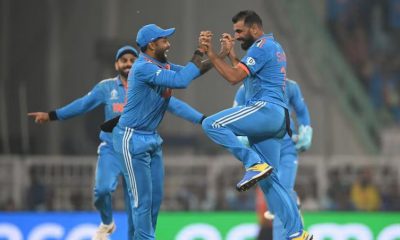

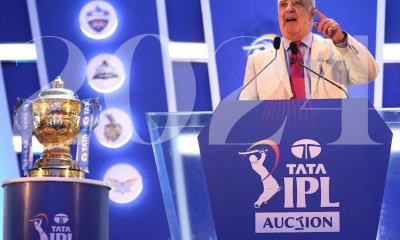

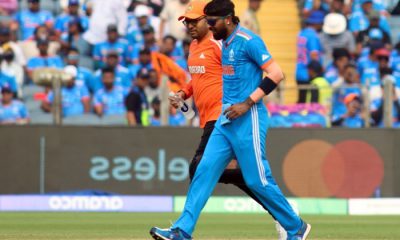





You must be logged in to post a comment Login